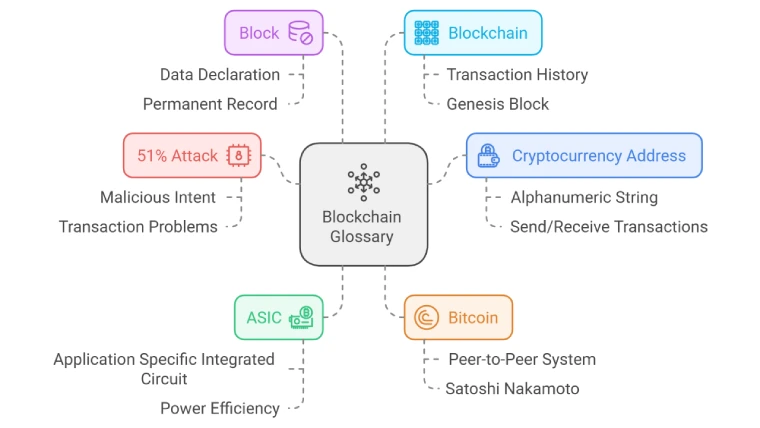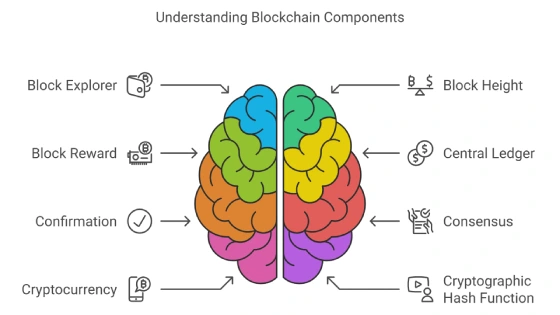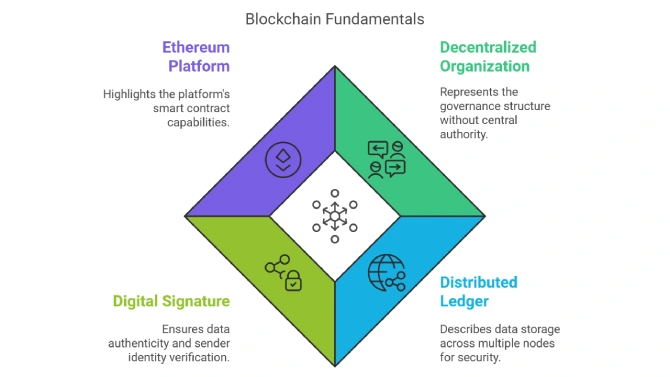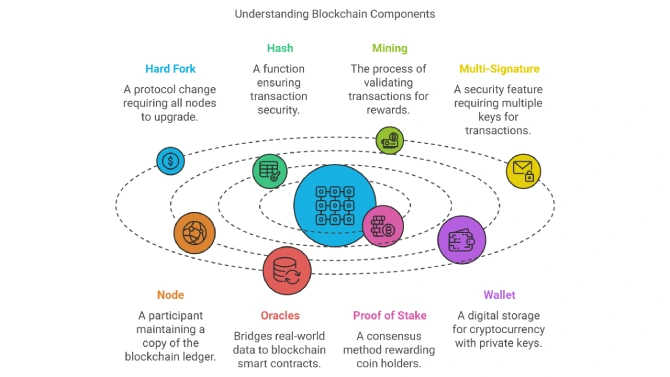Blockchain technology is revolutionizing industries across the globe, but for many, its complex terminology can be a significant barrier to understanding. Terms like “smart contracts,” “consensus mechanisms,” and “non-fungible tokens” (NFTs) often sound intimidating, especially to beginners. To bridge this gap, we’ve created a comprehensive Blockchain Glossary that explains these terms in simple, accessible language.
Do you wanna understand blockchain technology? Well, you should need to have a look at this Blockchain Glossary that refers to Blockchain all the briefing words. Try to read here the blockchain glossary with a short explanation.
Table of Contents
All the Blockchain Glossary Briefing: From A – Z
What Is A 51% Attack?
When up to half the CPU power of a digital currency network is generally dominated by any one or more groups, sometimes it may create problems for transactions and harm the network. Also probably caused the malicious intent to do so. Explanation of blockchain glossary, read the article so you can know about blockchain glossary.
What Is A Cryptocurrency Address?
For cryptocurrency transactions, you just need an address to send or receive money transactions on the network. Generally, we call it a wallet address, and the address is present as a string of alphanumeric characters.
Definition Of ASIC
‘Application Specific Integrated Circuit’ briefly ASIC. It is likened to GPUs, ASICs particularly used for mining and also assists in saving power significantly. Explanation of blockchain glossary, read the article so you can know about blockchain glossary.
Bitcoin
Bitcoin is a digital cash and peer-to-peer networking system. It is a fully decentralized cryptocurrency and there is no central authority to control it. Also, it is the first electronic cash that the first ledger started on January 3 2009 by someone apparently named Satoshi Nakamoto.
What Is A Block?
Blocks are stored on the Blockchain network. Moreover, blocks are packages of data that carry permanently recorded data on the blockchain network. Also, blocks consist of a single or more state or data declaration.
Blockchain
Blockchain is an open ledger where every transaction is recorded. This transaction is permanently recorded by appending blocks. The Blockchain indicates all the transaction history that ever occurred, all the blocks like a genesis block in the recent block and it is called the Blockchain. Read the article What is Blockchain?
What Is Block Explorer?
It is a helpful online tool to see all the transactions. You can see present, and past transactions on the Blockchain network. Additionally, you are able to see useful information like network hash rate and transaction growth.
What Is Block Height?
The Block Height refers to how many blocks are added to the blockchain network. For instance, the current Bitcoin block height is 554725.
Block Reward
In a word, a Block Reward is an incentive bonus for completing a mathematical problem-solving in a block during mining. The miner calculates a hash to validate a block in the blockchain network to add new coins. For doing this miners get rewarded a portion of the transaction.
Central Ledger
The central ledger means, that is maintained by a central authority.
Confirmation
The successful act of hashing a transaction and adding it to the blockchain network.
What Is Consensus?
Consensus refers to all the network members agreeing to validate a transaction on the blockchain. Additionally, it’s ensured everyone is getting copies of the ledger.
Cryptocurrency
Cryptocurrency is a digital currency. For example, Bitcoin is a cryptocurrency. Many of us are known as a token or coin those are digital assets.
Cryptographic Hash Function
Cryptographic hashes turn out a fixed-size and distinctive hash price from variable-size dealing input. The SHA-256 procedure rule is a computational algorithm example of a cryptographic hash.
Dapp
(Dapp) decentralized application stores the data on the blockchain network. Any central authority is not controlling it. Moreover, it is managed autonomously. Dapp is fully open source moreover, everyone can use it and incentives in the form of cryptographic tokens, and operates on a protocol that shows proof of value.
DAO
It is a decentralized organization that does not interfere with any human and all the activities are not controlled by a single authority. All of the processes are handled by an incorruptible set of business rules.
What is a Distributed, Ledger?
It does not carry its own currency and perhaps permission and privets. Also, it stores all the data on the network nodes.
Distributed Network
The distributed network refers to spreading all the data among the nodes and not centralizing the data.
Difficulty
Difficulty indicates in the blockchain world, how easily calculate and solve a mathematics problem. It also refers to how a transaction easily adds a block to be mined successfully.
Digital Signature
A web code created by public-key encryption is included in an electronically transmitted document to validate its data and sender identity.
Double Spending
One per transaction costs two times and we called it double-spending. The sender and receiver get fees for one transaction.
What Is Ethereum?
Ethereum is an open-source blockchain-based platform and smart contact featured functionality to protect third-party censorship, fraud, and control. The founder and author is Vitalik Buterin.
What Is EVM?
The Ethereum Virtual Machine (EVM) may be an Alan Turing complete virtual machine that enables anyone to execute discretion EVM computer memory unit Code. Each Ethereum node runs on the EVM to keep up consensus across the blockchain.
Fork
Fork refers to another version of the blockchain also, to blockchain network works simultaneously on various parts of the network.
Genesis Block
The first origin block or first few blocks of a blockchain.
Blockchain Glossary To Understand Blockchain Technology
Hard Fork
Through hard fork, all the previous invalidated transactions render to validate and vice versa. To do a hard fork there will need all the nodes and members of that blockchain upgrade to the latest session of the protocol software.
Hash
The hash function works and performs to output data. It needs to ensure coin transactions. However, It is one of the important blockchain glossaries.
Hash Rate
Hash rate calculates of operation in the Bitcoin code and the speed of the next block to complete the mining process.
Hybrid PoS/PoW
A hybrid PoS/PoW permits each Proof of Stake and Proof of Work as agreement distribution algorithms on the network. Making a system of community-based governance by each insider (holders) and outsider (miners).
Mining
It’s validating the blockchain transaction. This validating process declares the incentive for the miners. However, the miner gets awarded as a validator. Mining is a lucrative business in the cryptocurrency sphere. If you have powerful hardware you can earn a reasonable amount of money.
Multi-Signature
It is provided an extra security layer by the need for many keys to authorize a transaction.
Node
A single copy of the ledger from the blockchain network is handled by a participant. Food is one of the important blockchain glossaries.
Oracles
Its performance is a ghat between the real world and the blockchain network by giving data to smart contracts.
Peer to Peer
Peer-to-peer (P2P) refers to the decentralized interactions between 2 parties or additional in a very highly interconnected network. Participants of a P2P network deal directly with one another through one mediation purpose.
Public Address
It is a cryptographic hash of a public key. You can imagine an email account that can be present for anyone, unlike private keys.
Private Key
A private key is a string of data that allows you to access the tokens in a specific wallet. However, the private key should be secret.
Proof of Stake
A consensus distribution algorithm that rewards earnings based on the number of coins you own or hold. The more you invest in the coin, the more you gain by mining with this protocol.
Proof of Work
A consensus distribution algorithm that requires an active role in mining data blocks, often consuming resources, such as electricity. The more ‘work’ you do or the more computational power you provide, the more coins you are rewarded with. Explanation of blockchain glossary, read the article so you can know about blockchain glossary.
Script
It is like a cryptographic algorithm. Also, it is used by Litecoin. Similar to SHA-256 it is quicker as it does not use up much processing time.
SHA-256
SHA-256 is a particular cryptographic algorithm. Basically used for crypto, for example, Bitcoin.SHA-256 needs huge computing power. Need process time and enforcement of mining pool to the blockchain network. Explanation of blockchain glossary.
Soft Fork
A soft fork is a slit different from a hard fork. It makes an invalid previous transaction. All the past nodes execute in the new block as valid. It is important for a soft fork for backward compatibility. To complete this fork miners need upgrading moreover a hard for need all the nodes to agree with the recent version.
Solidity
It is a programming language and it’s used on Ethereum to develop a smart contract.
Testnet
A test blockchain is used by developers to prevent expanding assets on the main chain.
Transaction Block
Many transitions are stored in a block after they are hashed and finally run on the blockchain.
Transaction Fee
To transact any amount of crypto there is little charge. To complete this transaction, it adds up the block. The miner gets a reward for it.
Turing Complete
Turing Complete refers to the flexibility of a machine to perform calculations that the other programmable laptop is capable of. An example of this can be the Ethereum Virtual Machine (EVM).
Wallet
Simply, a wallet refers to a store of crypto money. Used file in a place with private keys. Wallet as act a software client where the user has access to see transactions on the relevant blockchain network. Explanation of blockchain glossary, read the article so you can know about blockchain glossary.
Finally, Blockchain technology is a new revolution on the internet. Blockchain glossary helps you understand blockchain technology. It gives you a good sense of cryptocurrency. So, read every day at least one blockchain glossary. Explanation of blockchain glossary, read the article so you can know about blockchain glossary.
Multimedia Enhancements
Adding multimedia elements enhances user engagement by catering to diverse learning styles. Interactive videos and podcasts can clarify terms that are hard to explain in text alone.
Examples of Multimedia Content:
- Explainer Videos:
- Create a 2-minute video showing how a block is added to the blockchain, including hashing, timestamping, and linking.
- Podcasts:
- Embed episodes from reputable blockchain podcasts like “Unchained” discussing hot topics like NFTs or DeFi.
- Interactive Animations:
- Show animations of blockchain forks or a visual walkthrough of how a transaction moves through the network.
Emerging Terminology
The blockchain ecosystem evolves rapidly. Adding emerging terms and trends ensures your glossary remains relevant and forward-thinking.
Emerging Terms to Include:
- Decentralized Finance (DeFi):
- Explanation: A financial ecosystem built on blockchain, offering services like lending, borrowing, and trading without banks.
- Example: Uniswap, a decentralized exchange, enables peer-to-peer trading without intermediaries.
- Non-Fungible Tokens (NFTs):
- Explanation: Unique digital assets stored on blockchain, used in art, gaming, and collectibles.
- Example: Beeple’s $69M NFT auction or Axie Infinity’s in-game assets.
- Layer 2 Scaling:
- Explanation: Technologies that operate on top of blockchains to improve scalability and reduce fees.
- Example: Polygon for Ethereum or Lightning Network for Bitcoin.
- Interoperability:
- Explanation: The ability for different blockchains to communicate and share data.
- Example: Polkadot’s parachains or Cosmos’s inter-blockchain communication (IBC).
Why It’s Valuable:
By staying updated with new terminology, you’ll position your glossary as a trusted resource for blockchain enthusiasts.
Cross-Referencing Related Terms
Blockchain terms are deeply interconnected, and linking related concepts allows readers to see the bigger picture.
Examples of Cross-References:
- Proof of Stake (PoS): Link to terms like “Validator” and “Staking Rewards” for deeper context.
- Tokenization: Cross-reference with “NFTs” and “Security Tokens” to differentiate their uses.
- Forks: Relate to “Hard Fork” and “Soft Fork” for clarity on blockchain updates.
Implementation:
- Use hyperlinks to connect terms within the glossary.
- Provide a “See Also” section at the end of each entry to encourage further exploration.
Frequently Asked Questions (Blockchain glossary)
1. What is Blockchain?
Blockchain is a distributed ledger technology that records transactions across multiple nodes, ensuring transparency, security, and immutability. Each transaction is stored in a block, which is linked to previous blocks using cryptographic hashes.
2. How is Blockchain Different from a Traditional Database?
Unlike traditional databases, which are centralized and managed by a single entity, blockchain operates on a decentralized network of nodes. Data in a blockchain is immutable, meaning once it’s added, it cannot be altered or deleted.
3. What is the Difference Between Bitcoin and Blockchain?
Bitcoin is a cryptocurrency, while blockchain is the underlying technology that powers Bitcoin. Blockchain can be used for various applications beyond cryptocurrencies, such as supply chain management, healthcare, and voting systems.
4. What is a Smart Contract?
A smart contract is a self-executing program stored on a blockchain. It automatically enforces agreements between parties when predetermined conditions are met. Smart contracts are widely used in decentralized applications (dApps) and DeFi platforms.
5. What is the Purpose of Consensus Mechanisms?
Consensus mechanisms, such as Proof of Work (PoW) and Proof of Stake (PoS), ensure all nodes in a blockchain network agree on the validity of transactions. This prevents fraud and double-spending.
6. What is the Role of Cryptocurrency in Blockchain?
Cryptocurrencies, like Bitcoin and Ethereum, are digital assets used for transactions within blockchain networks. They often act as incentives for validators and nodes to maintain the network.
Conclusion
By implementing these extended enhancements, your blockchain glossary will evolve from a static reference guide into a dynamic, engaging, and highly educational resource. These updates will attract a wider audience, from blockchain beginners to industry professionals, and ensure your content remains a go-to resource for the latest blockchain knowledge.





